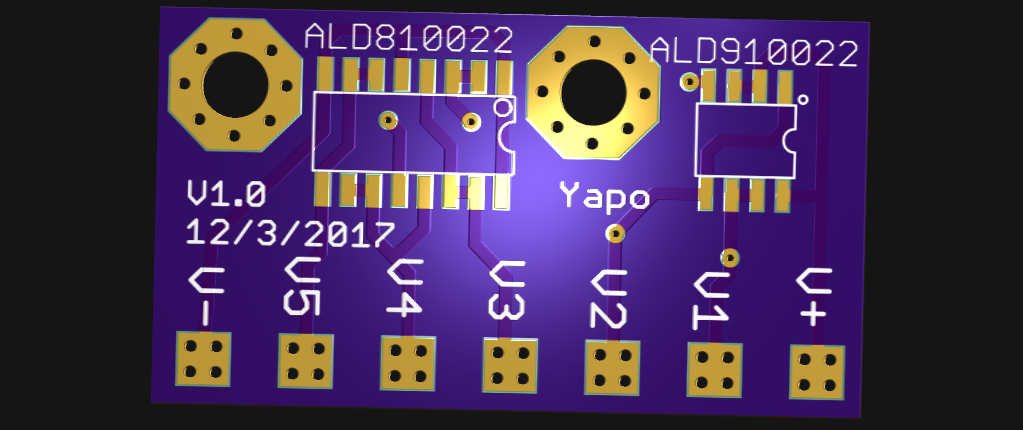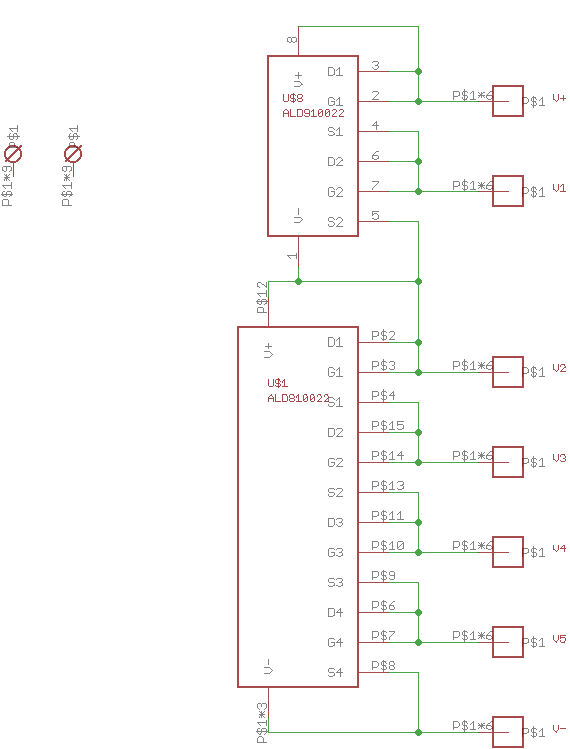Strings of capacitors have similar issues to strings of lithium ion cells: differences between cells can cause one or more cells in a string to become overcharged. In the case of capacitors, leakage current and capacity differences are the culprits.

To keep all the capacitors happy, you need a charge balancing circuit, so I designed a PCB around the ALD810022/ALD910022 Supercapacitor Autobalancing MOSFET IC's. These devices are amazingly simple in operation, using V/I curve of specially trimmed MOSFETs to shunt excess charging current around fully-charged capacitors. You simply need to connect the board pads to each node in the capacitor string. The Eagle design files for the PCB are in the GitHub repo.
ALD markets similar boards, which I will diplomatically call "high-margin items". You can get an un-populated PCB from DigiKey for around $20. The PCB above will cost you $5.35 for three copies at OSH Park. Even splurging for Super Swift service, I'm only paying $10.70 for three copies. Not bad.
The circuit is pulled right from the datasheet; the 8100 device contains 4 MOSFETs and the 9100 two of them, so both packages neatly handle six capacitors.

To see how these devices work, I ran a quick LTspice simulation using MOSFETs in the library - of course, these devices don't match the capacitor voltage I'll be using, but the qualitative behavior is similar.

C1, C2, and C3 represent capacitors with a spread of capacitance and leakage current (modeled with parallel resistors). The three MOSFETs start to shunt current around each capacitor as it reaches about
1.3V. For voltages above 4.0 for the string, the capacitor volatges become balanced, which you can see in this DC sweep:

With the ALD8100xx devices, ALD has accurately trimmed the V/I curve on each MOSFET instead of the random choice of devices I made in this rough simulation. In practice, you choose the version of the ALD ICs based on the maximum leakage current and maximum voltage for your capacitors.
Capacitor Selection
I chose to use a string of 6 SCCY68B407SSBLE capacitors from AVX. These caps are rated 400F at 2.7V, so the string of 6 will have a maximum 16.2V rating with 66.7F of capacitance. To select the proper ALD charge balancing IC's, I note from the datasheet that the capacitors have a maximum leakage current of 1000uA. From the ALD81-9100xx family datasheet, I see that the ALD{8,9}10022 parts have a forward voltage of 2.64V at 1000uA of current, which will keep each capacitor safely under the 2.7V limit. Perfect - DigiKey had them in stock, too. They're on the way.
The capacitors have a maximum ESR of 2.2mOhm, so the string of 6 will have 13.2mOhm resistance, plus whatever wiring I add. They are also specified for a 245A peak discharge current. This is probably enough to start most 4-cylinder engines, and maybe some 6-cylinder, but probably not my daily ride, which has a 4.7l V8. I may have to find another vehicle to experiment with. Then again, the ESR alone will allow currents of around 1000A, so if I use beefy wiring, maybe I can push the caps a little.
Either way, I'll have to make sure the engines are properly warmed up for the attempt(s). Cold oil is tough to get moving.
 Ted Yapo
Ted Yapo
Discussions
Become a Hackaday.io Member
Create an account to leave a comment. Already have an account? Log In.
The board is not shared on OSH Park, but the gerbers are in the GitHub repo. There's even a zip file in there ready to upload to OSH Park.
https://github.com/tedyapo/supercapacitor-balancer
Are you sure? yes | no
Hello Ted, I can't seem to find this board at OSH Park. Is it still available to order boards? Thanks, Gary
Are you sure? yes | no